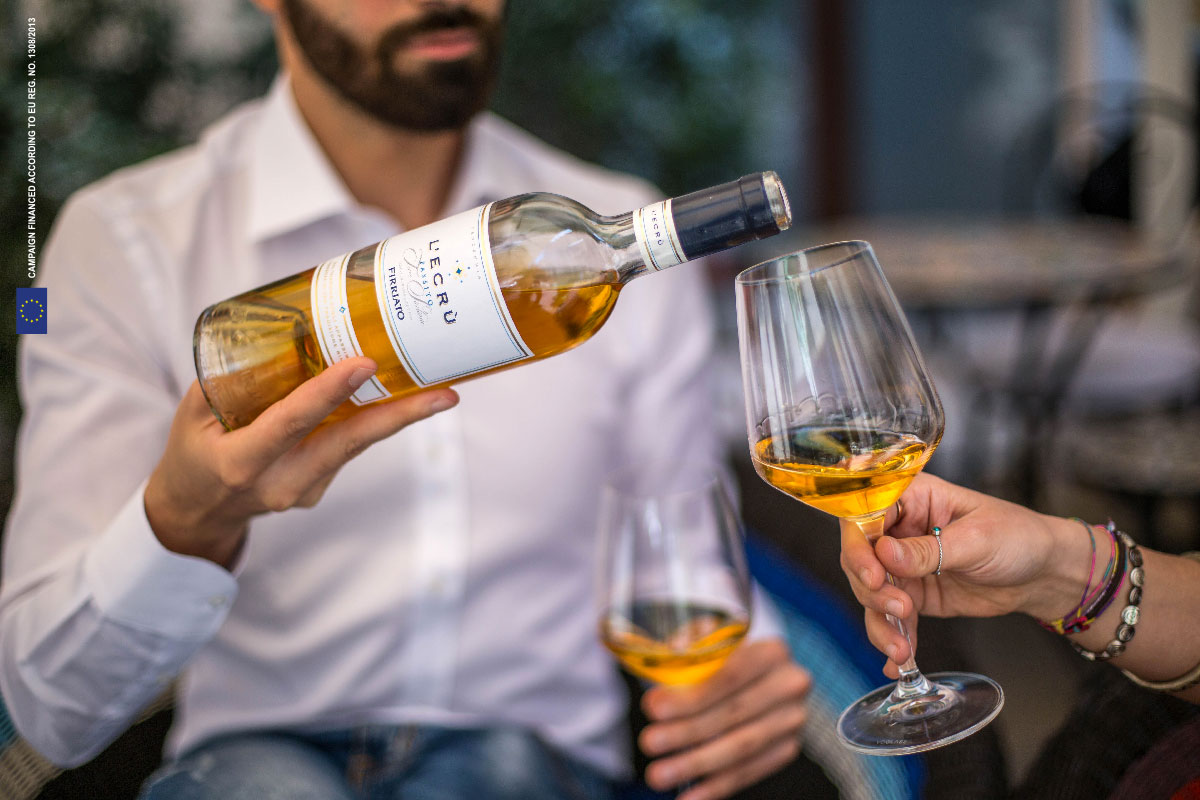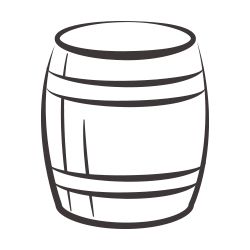The subtle elegance of an iconic wine
L'ECRÚ
Passito IGT Terre Siciliane
Zibibbo
L’Ecrù is a natural passito wine produced from Zibibbo grapes. For the vinification of this prestigious label Firriato employs a method of infusion which adds the dried grapes directly to the wine; this is absolutely unique within the field of Italian winemaking. The ‘raisining’ garden at Borgo Guarini forms the backdrop for this unique process. Sun and wind define the estate’s climate, and their combined action determines the natural drying process of the grapes over about 40 days. The slow drying process favours the concentration of fragrances of Mediterranean scrub in each grape. The grapes are then removed from the stalks and put in the wine to infuse, giving L’Ecrù its uniqueness. There are no prolonged, interrupted and restarted fermentations: in contact with the wine the grapes swell up and release their precious aromatic properties, creating an incomparably balanced passito.
L’Ecrù is a natural passito wine produced from Zibibbo grapes. For the vinification of this prestigious label Firriato employs a method of infusion which adds the dried grapes directly to the wine; this is absolutely unique within the field of Italian winemaking. The ‘raisining’ garden at Borgo Guarini forms the backdrop for this unique process.
- Appellation: Passito IGT Terre Siciliane
- Vine: Zibibbo
- Terroir: hilly
- Soil: mid-mixture, mostly clayey
- Exposure: south-west (1form 250 to 400mt. a.s.l)
Production Area
Borgo Guarini

Borgo Guarini, at 165 hectares, is Firriato’s largest Estate and it illustrates Sicily’s agricultural history, a guardian of its land and oldest traditions. The colours of this landscape are vivid and iridescent like the unique light which defines this unspoilt backdrop.

L'Ecrù
Infused passito
L’Ecrù is an unusually fine, natural, sweet wine. The glint and sparkle of its rich golden colour bewitch you with their balance of uncommonly elegant Mediterranean fragrances and floral aromas. The infusion technique is what makes L’Ecrù so throroughly agreeable, showing up in the elegant bouquet of intense fragrances that exquisitely erupt in the glass with composite and sophisticated notes. On the palate it displays aromatic notes of honey, orange blossom, and citronella that delicately unite with the fragrances of dates and orange peel. L’Ecrù is a genuine joy for the senses that keeps its freshness and supporting acidity completely intact.
L'Ecrù
High agronomy, infusion and extraordinary fragrances
L’Ecrù’s infusion method comes from a long, slow process which starts in the Zibibbo vineyards of Borgo Guarini. For this prestigious label Firriato calls on multiple agronomic techniques, with the aim of already obtaining on the plant the best grapes for each subsequent phase of vinification. The traditional Guyot vine training system has been experimented with to create a real specialisation in grape production, in order to obtain two distinctly different types of bunches, one for drying and the other for winemaking. To create L’Ecrù therefore requires two separate harvests.


L'ECRU'
The characteristics of vintages
2020
The 2020 harvest was influenced by climatic variations compared to the previous year, with temperatures higher than the seasonal average, especially between January and February, and a certain lack of rainfall from May to September. These conditions caused a slight advance in the budding phase, limiting the development and growth of the leaves until flowering, with a lower production yield, particularly for the white grape varieties, of around 30%. However, this has favored an exceptional quality, one of the best in recent years.
2019
The 2019 harvest is generally affected by the colder and rainier climatic trends compared to the averages of recent years. The rains distributed in winter and prolonged until late spring, with temperatures also below average and, above all the prevalence of winds from the north – sometimes even sustained, delayed budding and moved forward the whole process of development and growth of the ” foliar apparatus until flowering which, in the Trapani countryside led to a decrease in production:
2018
After a winter and a spring with abundant rainfall, summer did not make the thermometers soar and the sugar level was lower than in 2017. September recorded a slight increase in moisture and minimum temperatures compared to last year, but without ever causing particular phytosanitary problems. At the beginning of the third part of the same month there were copious rains (on the 21st and the 22nd) that slowed down the harvest, but fortunately without compromising the health of the grapes.
2017
Summer 2017 promised to be hot, with average temperatures around 35-36 degrees, including persistent heat peaks. Winter was generally mild and brought rainfall well distributed over all the vineyards of the Trapani countryside.
2016
The harvest began around the last period of July, the first decade of August, in the estates of the Trapani trapani. In the Borglo Guarini area the Zibibbo plants did not enter the water-heat distress during the hottest weeks and the land maintained discreet water supplies.
2014
It was an unforgettable vintage thanks largely to an almost uniform and very balanced climate, the spring was rightly rainy with cool summer which eased slow and gradual maturation. There is talk of ” a summer without Scirocco wind”,” July is spent without excessive heat. Parallel there were recorded very marked temperature day/night in all Firriato’s estate which helped the development of aromas and flavours.
2013
The growth cycle of the vine, in the period of flowering and, had a normal course. There were no anomalies during the veraison and ripening phases. The harvest for the early white varieties, started earlier than the previous year. Lucifer, Charon and the other this summer’s African anticyclones were a godsend for the vintage “exceptional year in terms of quality.”
2012
The growth cycle of the grape, in the period of flowering and fruit set, had a normal course. There weren’t any anomalies during the phases of veraison and ripening. The harvest, for precocious white varieties, started earlier than the previous campaign. Lucifer, Charon and the other African anticyclones this summer have been a godsend for the harvest “an exceptional year in terms of quality.”
2011
The growth cycle of the vine, in the period of flowering and has had a normal course. There were no anomalies during phases of veraison and ripening. The harvest for the white varieties early, started earlier than in the previous campaign. Lucifer, Charon and the other anticyclones Africa this summer has been a godsend for the harvest “an exceptional year in terms of quality.”
2010
Overall, 2010 saw lower than average rainfall and temperatures, with abundant rainfall at the end of autumn and spring. This favoured a period of rest followed by invigoration of the vines, even though there was a slight delay in bud break and flowering. The muggy weather in August and cool, wet weather in September, with temperatures ranging from 20 to 22°C, together with considerable differences in temperature between day and night, accelerated the ripening process resulting in a good harvest.
2009
The weather conditions were variable in 2009 with abundant rainfall during the winter, evenly spread throughout the spring and plentiful from the middle of September. It was a very unusual year, notable for the low temperatures recorded during one of the coldest winters experienced in the last few years. The summer was warm and dry until the rain arrived at the end of the summer months. The considerable differences in temperature recorded on the Borgo Guarini estate favoured grape ripening and the grapes were ready for harvest on 21st August for the grapes to be dried and September 15th for the base.
2008
The scarce rainfall and mild temperatures recorded this year did not affect the growth of the vines, which produced healthy, ripe fruit, a small percentage of which was treated with sulphur. The harvest on the Borgo Guarini estate started on 26th August for the grapes to be dried and 20th September for the base; the grapes were hand picked thanks to the care and local knowledge of the labourers. Nature and agricultural techniques helped to produce a fragrant and aromatic wine with a pleasant complexity on the nose.
2007
The productivity of the vines fell by 40% this year due to an attack of peronospora, a mould that develops after abundant rainfall, and the strong and persistent sirocco wind. Timely action from those caring for the plants managed to save them and although the yield was lower than in previous years, the grapes ripened perfectly producing sweet, aromatic fruit.
L'ECRU'
Awards
2016
Vini Buoni d’Italia: 3 Stars
Wine Hunter Award: Wine Hunter Award Gold
Luigi Veronelli: 2 Red stars
Bibenda: 3 Green bunches
2014
Luigi Veronelli: 3 Stars
Vini Buoni d’Italia: 3 Stars
The Drunken cyclist: 92-94
2013
Robert Parker: 92 pts
Bibenda: 5 clusters
Decanter: Silver Medal 90 pts
2012
Bibenda: 5 clusters
Luigi Veronelli: 3 Red glasses
2011
Annuario dei Migliori Vini Italiani: 91 pts
Luigi Veronelli: 3 super stars
Bibenda: 5 green clusters
2010
Annuario dei Migliori Vini Italiani: 97 pts
Bibenda: 5 clusters
2009
Annuario dei Migliori Vini Italiani: 93 pts.- The best producer of the year
Bibenda: 5 clusters
Luigi Veronelli: 3 Red stars
2008
Annuario dei Migliori Vini Italiani: 95 pts.
Bibenda: 5 Clusters
Luigi Veronelli: 3 Red stars
2007
Bibenda: 5 Clusters
Robert Parker: 90 pts.
La Guida ai Vini – Giornale di Sicilia: 5 Stars


Paired with
Genovesi Sicilian Pastry
Put the flours, sugar, and salt in a large bowl and mix together. Cut it in the butter with a pastry blender or 2 knives until the mixture is crumbly. Stir in the egg yolks, one at a time. Add just enough water so that the dough begins to stick together.
Form the dough into a ball, wrap it in plastic film, and refrigerate for at least 30 minutes.



















